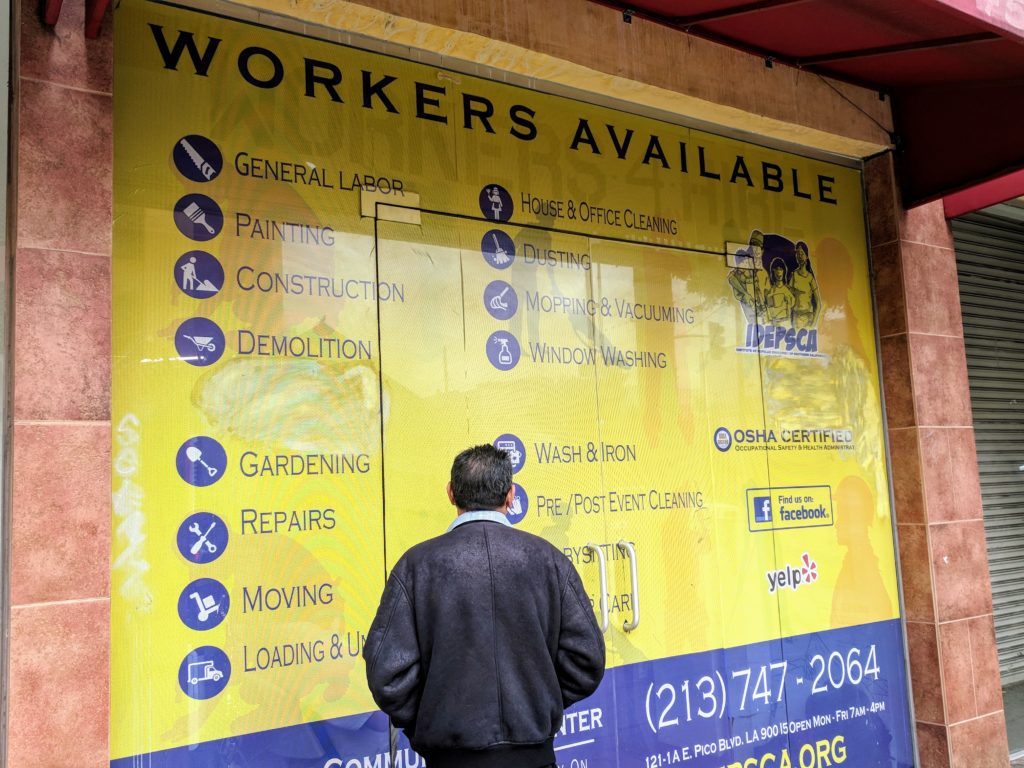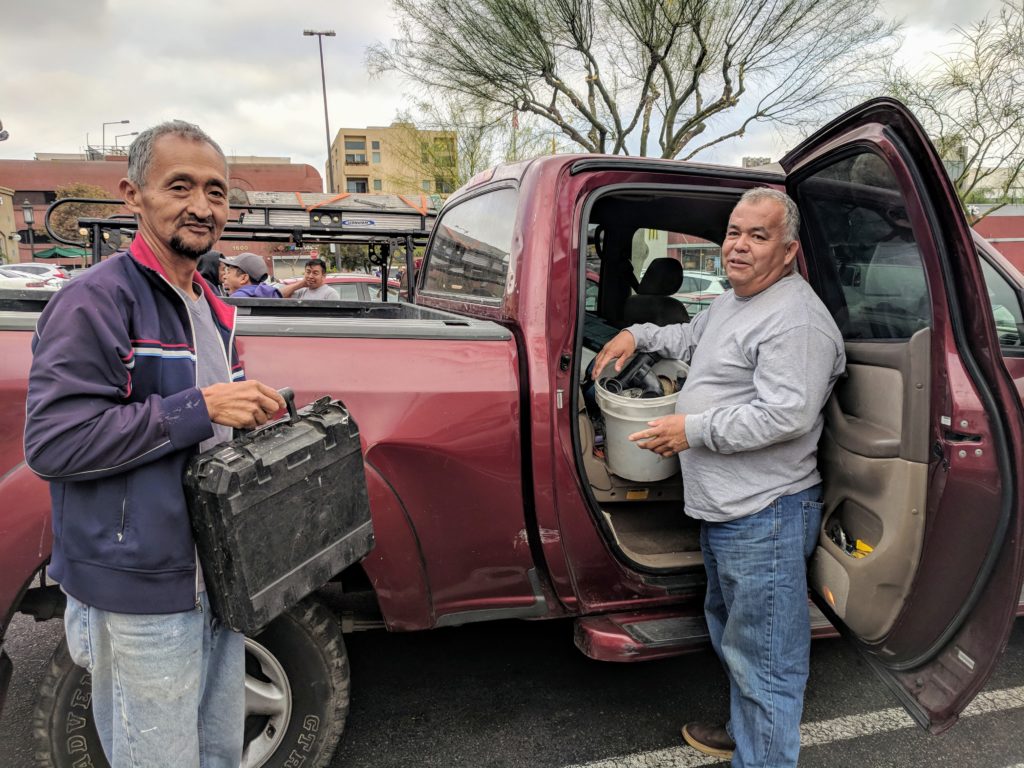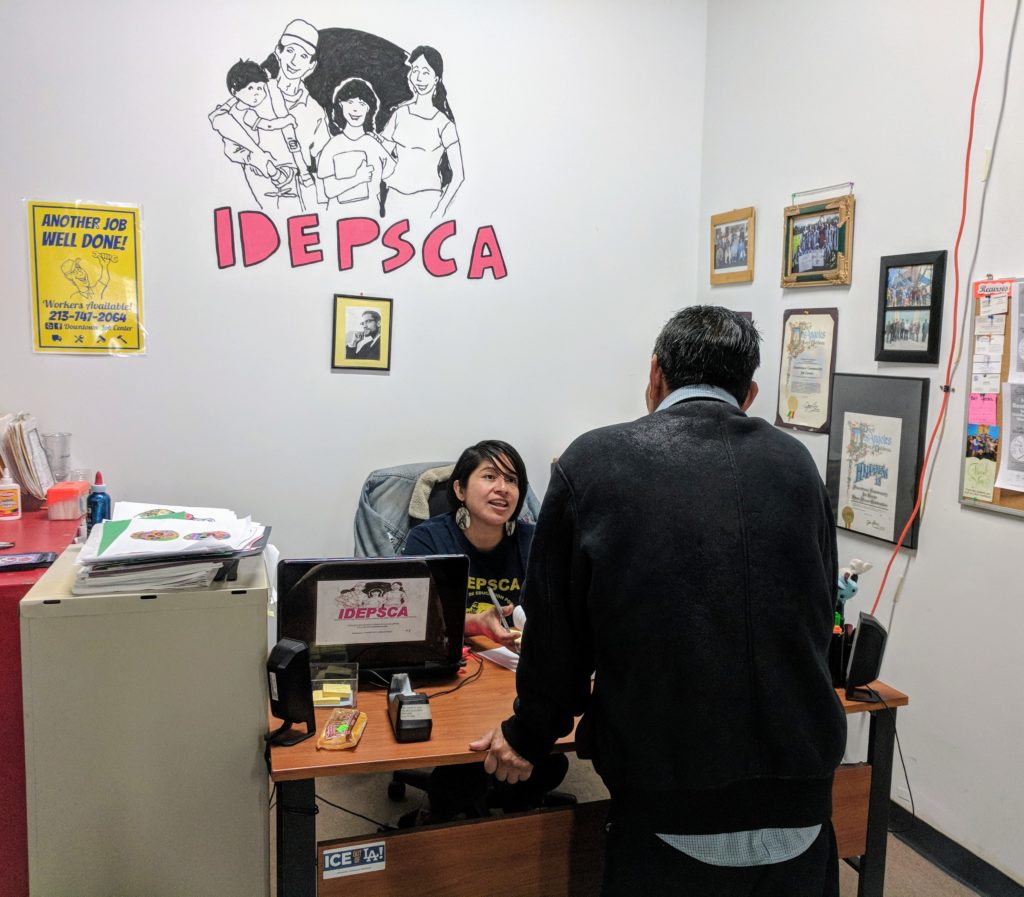By Jacqueline García. Click here to read this article in Spanish.

Without Social Security benefits or pensions, day laborers approaching later life face difficult years ahead.
Every morning, Eduardo arrives at a day laborer center in Los Angeles to pick up his crew for the day. Depending on the working schedule, the 52-year-old man takes between two and four men to work in different projects, mainly in construction.
“Sometimes other [day labor workers] laugh at me because I often take the older men,” said Eduardo. “But I take them because they have less opportunity to be hired,” said Eduardo. For many years he also worked as a jornalero, a day laborer doing different types of work, such as gardening, construction, loading, plumbing and other physical work.
One of his most loyal workers is Gerardo, 55, who arrived in the United States 12 years ago and has also worked mainly as a jornalero.
Gerardo, who did not want to provide his last name, said he left his wife and four children in Guatemala. “Well, one comes [to the U.S] to leave poverty and because without my help, my children over there [in Guatemala] wouldn’t be able to succeed,” he said.
Ongoing Risk
Jose, 55, arrived from his native El Salvador 33 years ago, fleeing the civil war there. Due to the lack of information, he did not obtain a work permit when he had the opportunity and, due to his lack of a legal status, he works as a day laborer.
“At five in the morning I am already up and coming here to look for a job,” said José, who also asked not to reveal his last name. “Sometimes I find [work], sometimes I don’t.”
The undocumented immigrant said that being a day laborer is difficult and dangerous. “People come and grab us with lies saying they will pay us, and because of our ignorance we do all the work and then they disappear,” said José. Only a few days before this interview, he reported, he was hired for a project and at the end of it he didn’t get paid.
“There they had me mixing cement for four days and when I finished, the one who hired me left,” he said.
Eduardo arrived to the United States at the age of 22 from his native Guatemala. Throughout the years as a jornalero, he said, sometimes he had to work on big and expensive jobs and at the end of the day he didn’t get paid. Sometimes he got threatened with calling immigration, or people gave him excuses to evade payment.
“And I have to pay my workers out of my pocket,” he explained.

Looking Toward Retirement
Studies have revealed that people in the United States depend mainly on three types of resources for retirement: Social Security, private pensions and personal savings or assets. That approach is especially difficult for those who are undocumented and working on unstable jobs such as day labor.
A group of approximately 20 jornaleros interviewed for this story said they do not have a concrete retirement plan. Everyone knows that there will be a time when they won’t be able to perform certain tasks. That will sharply reduce their opportunity to earn a few dollars for a day of work.
Gerardo said that from time to time he thinks about his future and hopes, like many other immigrants, to return to his native country. But he is not convinced that will happen. “My wife tells me to come back to be with them, but I tell her to give me at least until 2018, because I have to get the two young ones to be able to graduate from school,” said Gerardo. Besides supporting his children and wife, he also helps provide for his mother.
Because he worries about getting old and losing energy, Gerardo hopes to save more money before returning to his country.
Meanwhile, Eduardo and José say that despite their undocumented status they do not want to return to their home countries.
“The situation in my country is precarious and my children live in Texas,” said Eduardo. “I know that the day will come when physically I will not be able to work anymore, but mentally I’m always looking [for ideas],” he confided.
José said that of his relatives his mother was the only one left in El Salvador, but she died five years ago. Because he lacked legal documents, he could not risk even going back for her funeral. He explained, “I do not have anyone there, my children were born here and they are the only thing I have.” He added that he ignore thinking about what his future might bring as he grows older.
Although a large number of undocumented immigrants work and pay taxes in the United States, they are not eligible to receive a Social Security retirement pension or any other federal benefit. (According to the Social Security Administration, “While unauthorized immigrants worked and contributed as much as $13 billion in payroll taxes to the OASDI program in 2010, only about $1 billion in benefit payments.”)
They are also excluded from receiving assistance from programs such as the Supplemental Nutrition Assistance Program (SNAP, formerly known as the Food Stamp Program), non-emergency Medicaid, Supplemental Security Income (SSI) and Temporary Assistance for Needy Families , according to the National Immigration Law Center.
Social Security requires that workers pay into the system from their earnings for at least 40 quarters before they can receive benefits. Unfortunately, many immigrants, such as the undocumented and the visa holders, do not meet eligibility requirements, explains a study from the Social Security Office of Retirement and Disability Policy.

What Are Their Options?
Day labor centers throughout the U.S. offer help to laborers. They provide information such as about their rights as workers and fair wages—regardless of their immigration status—or where to find English classes or basic health services. Sometimes help comes from nonprofit organizations or private companies offering legal assistance or sometimes free food or tokens for the bus.
Guadalupe Garcia, an organizer with the Institute of Popular Education of Southern California (IDEPSCA), said that the day labor center—located in the area known as Fashion District (or the “alleys”) in the Downtown Los Angeles—has an daily arrival of approximately 25 day laborers looking for work, but they have more than 1,000 members who they aid during the year.
“Here most of the work available is unloading containers,” said Garcia. “And we teach them, for example, how much they should charge depending on the work they do.”
Several Latin American consulates help in a limited way. For example, the Consulate of El Salvador offers different forms of protection, such as assistance in repatriation to the country for vulnerable citizens, such as those who are sick, injured or minors.
The Consulate General of Mexico in Los Angeles has a program of vulnerable cases where they help Mexicans regardless of their immigration status.
Silvia Villegas, in charge of special cases at the Mexican Consulate, said she is primarily in charge of helping people obtain their identification documents, such as a passport, registration or voter credentials, so that they can eventually carry out other procedures either in this country or in case they decide to return.
“Many people have lost contact with their relatives, and it is very difficult to prove their identity,” explained Villegas. “I have had people who have been living here for 40 years or more and do not have any form of identification.”
Villegas said they do everything possible to contact the civil registry of the state in question in Mexico and are responsible for obtaining some type of identification the same day to continue with other procedures.
In relation to health care, undocumented immigrants are eligible for emergency Medicaid (the state and federal program called Medi-Cal in California that provides health coverage to low-income people). However, undocumented immigrants are only covered for serious medical situations. That may include birth, for instance, but not long-term care for chronic diseases, regardless of whether or not the condition is life threatening.
In California, the federal government provides about $2 billion dollars per year for emergency Medi-Cal or less than 1% of the general Medicaid budget. It is believed that approximately half of the total is received by California and the majority of this cost is for undocumented immigrants.
Migrant day laborers interested in learning more about their options can visit centers such as IDEPSCA, the Central American Resource Center, the Coalition for Pro-Immigrant Rights of Los Angeles (CHIRLA) or each immigrant’s consulate, depending on the person’s nationality.
Jacqueline García wrote this article for La Opinión in Los Angeles with the support of a journalism fellowship from New America Media, the Gerontological Society of America and AARP.
The opinions expressed in this article are those of the author and do not necessarily reflect those of the Diverse Elders Coalition.

